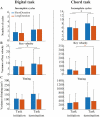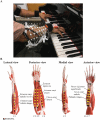Exhausting repetitive piano tasks lead to local forearm manifestation of muscle fatigue and negatively affect musical parameters
- PMID: 33854088
- PMCID: PMC8047012
- DOI: 10.1038/s41598-021-87403-8
Exhausting repetitive piano tasks lead to local forearm manifestation of muscle fatigue and negatively affect musical parameters
Abstract
Muscle fatigue is considered as a risk factor for developing playing-related muscular disorders among professional pianists and could affect musical performance. This study investigated in 50 pianists the effect of fatiguing repetitive piano sequences on the development of forearm muscle fatigue and on piano performance parameters. Results showed signs of myoelectric manifestation of fatigue in the 42-electromyographic bipolar electrodes positioned on the forearm to record finger and wrist flexor and extensor muscles, through a significant non-constant decrease of instantaneous median frequency during two repetitive Digital (right-hand 16-tones sequence) and Chord (right-hand chords sequence) excerpts, with extensor muscles showing greater signs of fatigue than flexor muscles. In addition, muscle fatigue negatively affected key velocity, a central feature of piano sound intensity, in both Digital and Chord excerpts, and note-events, a fundamental aspect of musicians' performance parameter, in the Chord excerpt only. This result highlights that muscle fatigue may alter differently pianists' musical performance according to the characteristics of the piece played.
Conflict of interest statement
The authors declare no competing interests.
Figures








Similar articles
-
Are the forearm muscles excited equally in different, professional piano players?PLoS One. 2022 Mar 22;17(3):e0265575. doi: 10.1371/journal.pone.0265575. eCollection 2022. PLoS One. 2022. PMID: 35316295 Free PMC article.
-
Effect of induced extrinsic and intrinsic hand and forearm muscular fatigue on the control of finger force during piano playing.Hum Mov Sci. 2025 Feb;99:103319. doi: 10.1016/j.humov.2024.103319. Epub 2025 Jan 10. Hum Mov Sci. 2025. PMID: 39798224
-
Acute Neuromuscular Fatigability and Perceived Exertion in High-Level University Pianists: An Electromyography and Maximum Force Capacity Study.Med Probl Perform Art. 2023 Jun;38(2):121-128. doi: 10.21091/mppa.2023.2015. Med Probl Perform Art. 2023. PMID: 37260220
-
Electromyographical study on muscle fatigue in repetitive forearm tasks.J Huazhong Univ Sci Technolog Med Sci. 2007 Aug;27(4):358-61. doi: 10.1007/s11596-007-0403-8. J Huazhong Univ Sci Technolog Med Sci. 2007. PMID: 17828486
-
Antagonistic muscular co-contraction for skilled, healthy piano technique: a scoping review.Front Psychol. 2025 May 1;16:1386273. doi: 10.3389/fpsyg.2025.1386273. eCollection 2025. Front Psychol. 2025. PMID: 40376484 Free PMC article.
Cited by
-
What Does It Take to Play the Piano? Cognito-Motor Functions Underlying Motor Learning in Older Adults.Brain Sci. 2024 Apr 20;14(4):405. doi: 10.3390/brainsci14040405. Brain Sci. 2024. PMID: 38672054 Free PMC article.
-
Behavioral and physiological fatigue-related factors influencing timing and force control learning in pianists.Sci Rep. 2023 Dec 8;13(1):21646. doi: 10.1038/s41598-023-49226-7. Sci Rep. 2023. PMID: 38062126 Free PMC article.
-
Are the forearm muscles excited equally in different, professional piano players?PLoS One. 2022 Mar 22;17(3):e0265575. doi: 10.1371/journal.pone.0265575. eCollection 2022. PLoS One. 2022. PMID: 35316295 Free PMC article.
-
Micro-variations in timing and loudness affect music-evoked mental imagery.Sci Rep. 2025 Aug 22;15(1):30967. doi: 10.1038/s41598-025-12604-4. Sci Rep. 2025. PMID: 40846722
-
The effect of static stretching on key hits and subjective fatigue in eSports.J Phys Ther Sci. 2021 Dec;33(12):891-897. doi: 10.1589/jpts.33.891. Epub 2021 Dec 1. J Phys Ther Sci. 2021. PMID: 34873369 Free PMC article.
References
-
- Bruno S, Lorusso A, Caputo F, Pranzo S, L’Abbate N. Musculoskeletal disorders in piano students of a conservatory. G Ital. Med. Lav. Ergon. 2006;28:25–29. - PubMed
-
- de Oliveira CFC, Vezzá FMG. Musicians’ health: Pain resulting from playing musical instruments among members of orchestras of the ABCD region, São Paulo, Brazil. Rev. Bras. Saúde Ocup. 2010;35:33–40. doi: 10.1590/S0303-76572010000100005. - DOI
-
- Sousa, C. M. G. de. Occupational diseases among professional orchestra musicians from the North of Portugal—treatment with tuina techniques. (2017).
Publication types
MeSH terms
LinkOut - more resources
Full Text Sources
Other Literature Sources

